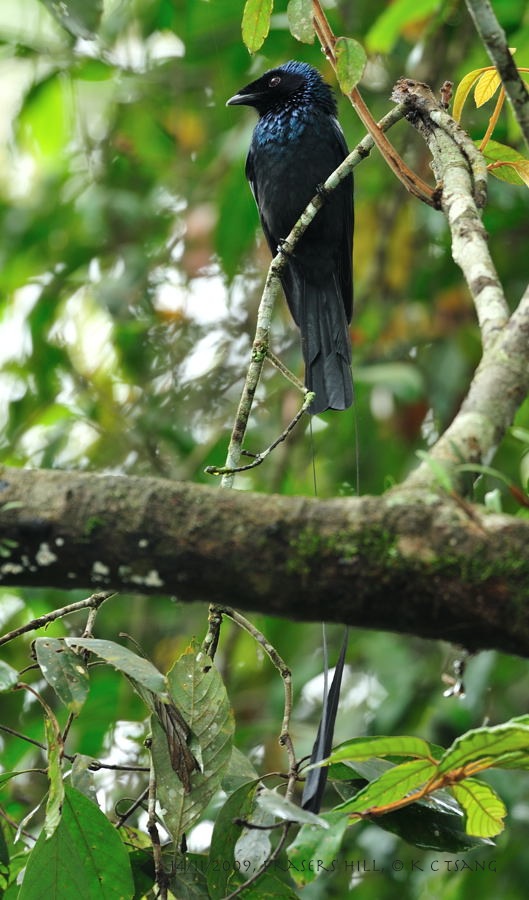Alternative name: Lesser Racquet-tailed Drongo
- Dicrurus remifer
Identification
23 - 24cm. A small drongo.
- Black plumage, strongly glossed metallic blue-green or purple
- Flat-headed appearance from low nasal crest over base of bill
- Squared tail with very long wires and flat rackets (sometimes missing)
- Dark reddish-brown or crimson eye
Sexes similar, females are slightly smaller than males. Juveniles are dull black and racket-less.
Similar species
Note that may lack outer rackets. Differs from Greater Racket-tailed Drongo by crestless forehead and square-cut tail. Also note head shape. Bronzed Drongo has a well forked tail.
Distribution
Himalayas and southern China through southeast Asia to Sumatra and Java.
Locally common in its range.
Taxonomy
Four subspecies recognized:
- D. r. tectirostris in the lower Himalayas from north India east over Nepal, Bhutan to northeast India, south China (Tibet, Yunnan, Guangxi), east Bangladesh, Burma, northern Thailand, northern Laos and northern Vietnam
- D. r. peracensis in south Burma and southwest Thailand and south to northern peninsular Malaysia, south Laos and south Vietnam
- D. r. lefoli restricted to the mountains of south Cambodia
- D. r. remifer on Sumatra and western Java
Habitat
Moist broadleaf evergreen and deciduous forest. Often seen at shaded edges of openins, fire-lines, cultivation clearings and forest streams. In China also in dry open woodland and bamboo-jungle. Occurs at 900 - 2000m in India, up to 2500m in Sumatra. Replaces Greater Racket-tailed Drongo at higher elevations (but overlaps with it at lower altitudes).
Behaviour
Feeds mainly on insects, also reported to feed on nectar. Hawks prey beneath canopy, dashing from perch to which it returns afterwards. Usually seen singly or in pairs. Joins mixed-species flocks, sometimes together with Greater Racket-tailed Drongo.
Breeding season from April to June. The nest is a small shallow cup made of fine roots or other vegetable fibres. It's placed in a tree, usually less than 7m above the ground. Lays 3 or 4 eggs.
A mainly resident species. Some altitudinal movement in the Himalays noted and also a summer visitor in parts of China.
Vocalisation
Repertoire of melodious whistles. Also harsh churrs typical of the family.
References
- Clements, JF. 2009. The Clements Checklist of Birds of the World. 6th ed., with updates to December 2009. Ithaca: Cornell Univ. Press. ISBN 978-0801445019.
- Del Hoyo, J, A Elliott, and D Christie, eds. 2009. Handbook of the Birds of the World. Volume 14: Bush-shrikes to Old World Sparrows. Barcelona: Lynx Edicions. ISBN 978-8496553507
- Rasmussen, PC and JC Anderton. 2005. Birds of South Asia: The Ripley Guide. Barcelona: Lynx Edicions. ISBN 978-8487334672
Recommended Citation
- BirdForum Opus contributors. (2025) Lesser Racket-tailed Drongo. In: BirdForum, the forum for wild birds and birding. Retrieved 29 April 2025 from https://www.birdforum.net/opus/Lesser_Racket-tailed_Drongo





